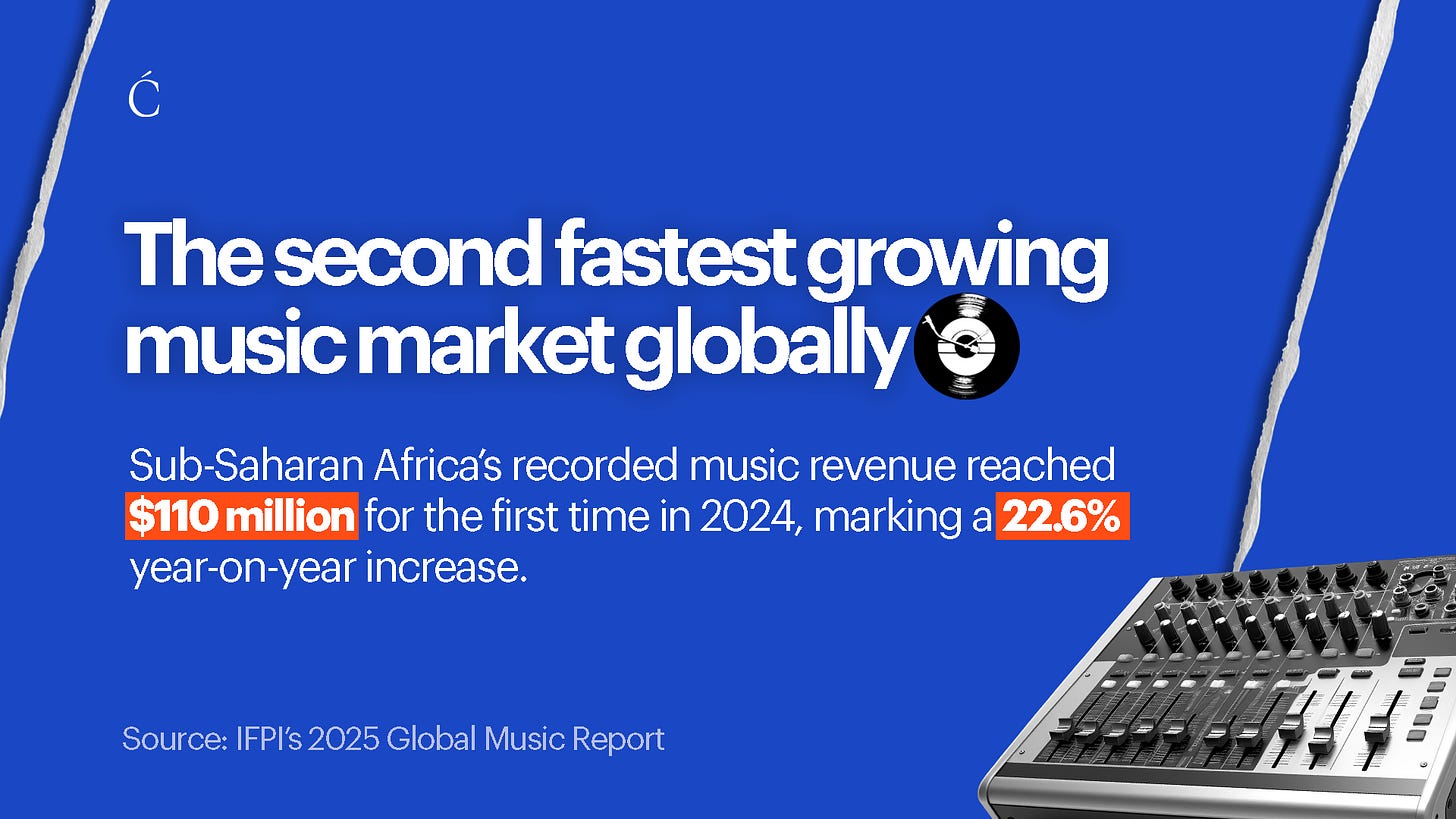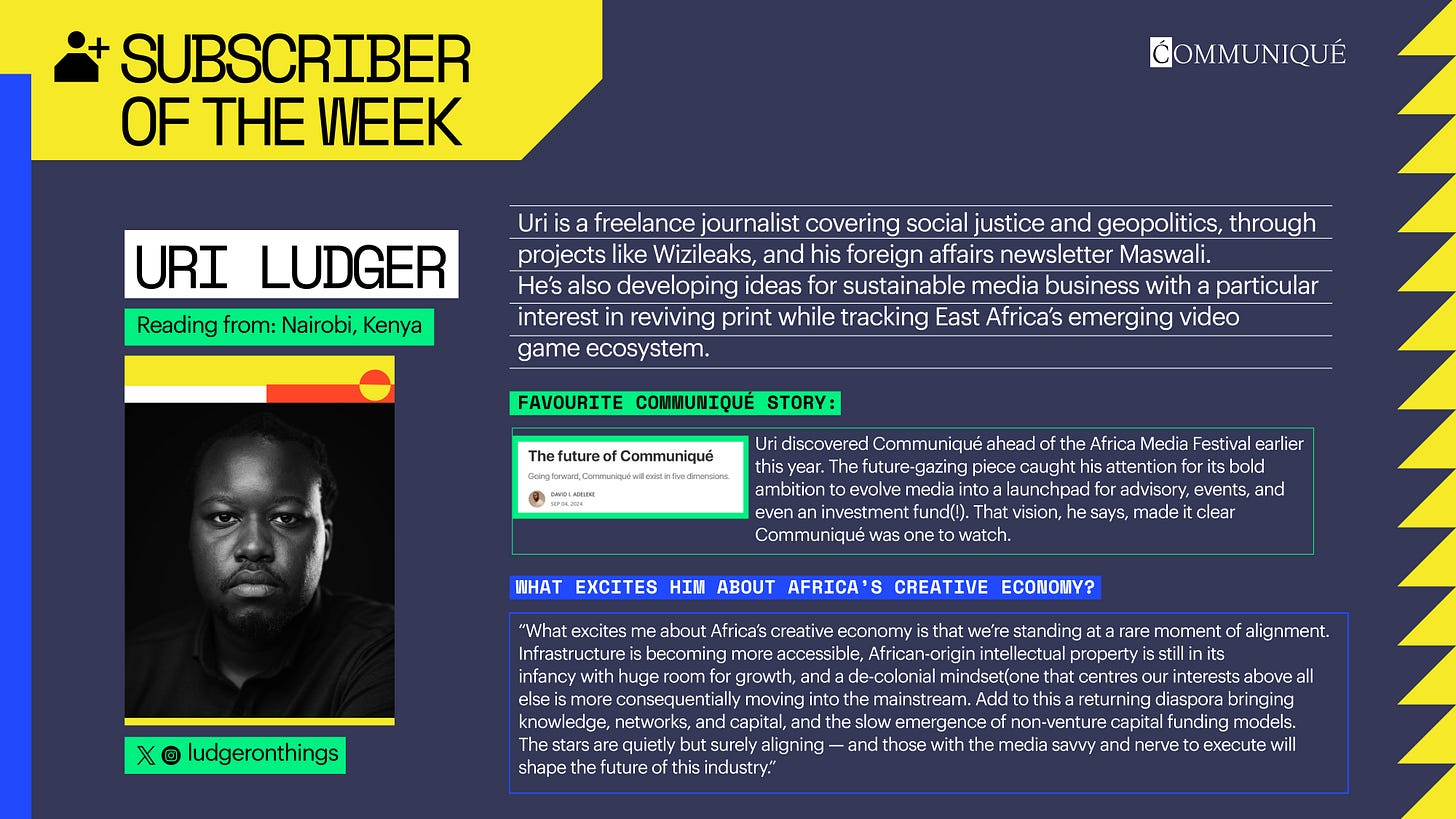Billboard’s plan to map African music + the messy business of skit making in Nigeria
We explore Billboard Africa’s plans and what the claim of Nigerian comedy skit makers making $300k monthly leaves out.
Hello,
This week, we’re turning the spotlight on you. We’re adding a new section—Subscriber of the Week—to celebrate the people behind the inboxes. Each week, we’ll feature someone from our community, sharing who they are, what they’re working on, and what excites them about Africa’s creative future.
Enjoy reading Communiqué? Tell a friend. The more minds in the room, the better the conversation.
In today’s Digest, we discuss:
How Billboard hopes to shape the music narrative in Africa
If making $300,000 a month is a thing for most Nigerian comedy skit makers
Center Spread 🗞️
Billboard charts a new course in Africa
Earlier this month, iconic American music publication Billboard announced that it will begin publishing content and hosting events focused exclusively on Africa’s music ecosystem via a new publication, Billboard Africa.
The move comes at a moment of growing global recognition for African music. Major international labels, including Universal, Sony, and Warner, have expanded their operations into key African markets. For Billboard, the timing reflects both Africa’s increasing cultural capital and the commercial potential of its music industry. Notably, the publication will set up shop in Botswana with backing from Global Venture Partners, a Dubai-based venture capital firm.
This is not Billboard’s first attempt to engage with the African music scene. In 2022, it introduced a dedicated chart for Afrobeats songs as a way to reflect the genre’s growing global influence.
But while Billboard’s entry reflects global validation, it is joining an ecosystem that has long been building its own infrastructure. Nigeria’s TurnTable Charts, for example, has been tracking music consumption and publishing localized rankings since 2020. There are also music-focused publications, like NATIVE Mag and Music In Africa, that have been documenting and shaping the continent’s music narratives for years.
Nkosiyati “Yati” Khumalo, former editor at GQ South Africa and former content lead at Apple Music Sub-Saharan Africa, was appointed as Billboard Africa’s founding editor. Speaking to Communiqué, Khumalo said: “We believe music is a unifying force, and our approach is to act not just as a media brand, but as a partner to the continent’s music ecosystem.”
Billboard Africa will begin publishing content in July, according to Khumalo. He offered a preview of what audiences can expect when the platform goes live.
“Billboard Africa will be covering all parts of the African music landscape, from genres that have captivated the world to new hybrids and styles that are emerging across the continent every day. We’re spotlighting the next generation of African superstars—not just the ones crossing over, but also those resonating deeply within their home countries and regions,” he said.
The unit economics of skit making in Nigeria
A video made the rounds on Nigerian social media last weekend thanks to claims that top comedy skit makers are earning $300,000 every month. It’s a bold, headline-grabbing figure, and one that deserves a closer look because the economics of skit-making tell a more complicated story.
Platform monetization remains the backbone of digital content earnings. Among all platforms, YouTube still offers the most structured and consistent payout system. While many Nigerian skit makers initially gain viral fame on Instagram or X (formerly Twitter), they prioritize YouTube as their primary revenue platform (Read Communiqué 45 for more information on this). Facebook only recently rolled out monetization tools in Africa and is still evolving. Instagram and X, by contrast, offer little in direct revenue; instead, they serve as brand billboards that help creators attract sponsorships.
Let’s talk numbers. YouTube’s CPM (Cost Per Mille) is what advertisers pay per 1,000 views of their ads, but creators only receive a portion of that—what’s known as RPM (Revenue Per Mille, i.e., per 1000 views of a video), after YouTube takes its ~45% cut. YouTube does not disclose its calculation method for these rates or publish them publicly. The available data is based on self-reported estimates, and these estimates vary significantly among individual creators.
CPMs fluctuate based on content niche, video length, audience size, and the viewer’s location. Finance content commands higher CPMs, while entertainment content, such as skits, tends to sit on the lower end. In Africa, RPMs typically range between $0.40 and $2.50, with entertainment videos averaging around $1. That means a video with 200,000 views might earn just $200, and 2 million views would generate roughly $2,000. So, a creator posting one skit per week might earn $800 to $8,000 a month, minus expenses such as scripting, production, crew, and marketing.
The viral clip was from a YouTube video profiling several top skit makers in the country. Interestingly, none of them disclosed exact income figures. The most specific estimate came from Obotuke Timothy Ochuko (SirBalo), who stated that it’s possible to earn $50,000 to $100,000 in a good month.
So where’s the rest of the $300,000 coming from?
According to the skit makers interviewed, platform earnings make up roughly half of their income. The rest comes from brand deals, event appearances, endorsements, and in many cases, other business ventures. Some even run multiple channels.
To put things in perspective: only two Nigerian skit makers have crossed the one billion views mark on YouTube, and fewer than 15 have more than a million subscribers. For most skit makers, $300,000 per month is aspirational, not typical, and even those who get close aren’t making it from content alone. The viral number may catch attention, but the real story lies in diversification, strategy, and building beyond the platforms.
Crunch Time 📈
Catch Up 📬
We’ve moved past content—what comes next for media companies?
Traditionally, a media company created content, packaged it, and sent it out into the world. Now, with a smartphone and an internet connection, anyone can do all that. We live in an era where everyone is a potential publisher. So the question is no longer how to be a media company, it’s what else a media company can be.
The latest Communiqué essay posits that media companies can (and should) add a third dimension to the two pillars of content production and audience-building: problem-solving. In other words, media companies shouldn’t just inform the public about problems; they should intervene and help build real solutions.
Read the full essay here.
Communiqué’s Subscriber of the Week 🤩
Curiosity Cabinet 🗄️
A tribute to the pioneers who laid the foundation for Nigeria’s modern creative economy.
Why pricing and affordability remain the Achilles’ heel of Nigeria’s ready-to-wear brands.
Uber Eats now lets South Africans order food from their seats at live events.
Here are the events happening next week in Africa’s creative economy
Zanzibar International Film Festival (also known as the Festival of the Dhow Countries), East Africa’s premier film event, kicks off on June 25 in Zanzibar.
The National Arts Festival, South Africa’s largest and longest-running multidisciplinary arts festival, begins a day after, on June 26, in Makhanda (formerly Grahamstown). Get your tickets here.
See what else is happening across the continent via Communiqué’s African Creative Economy Database.





